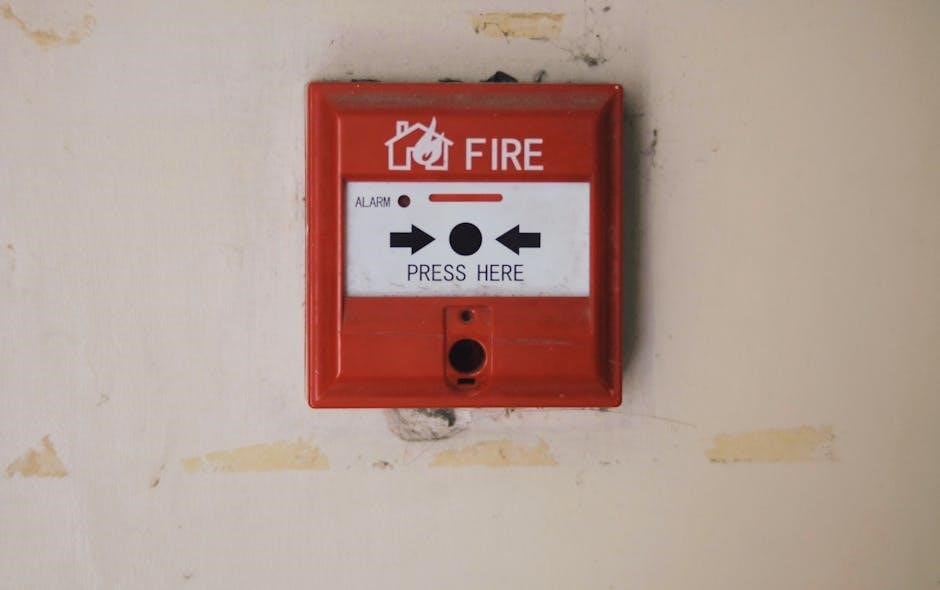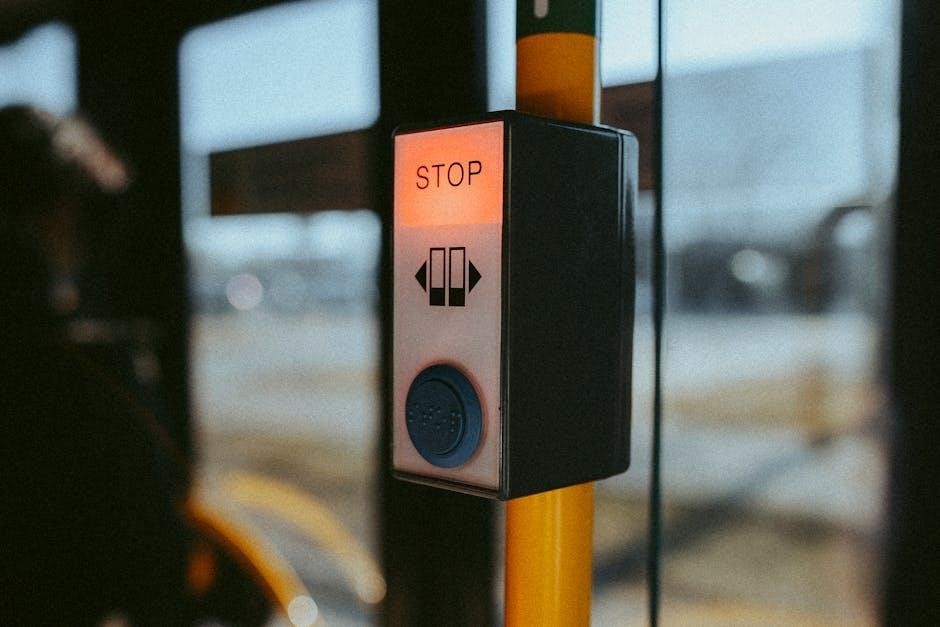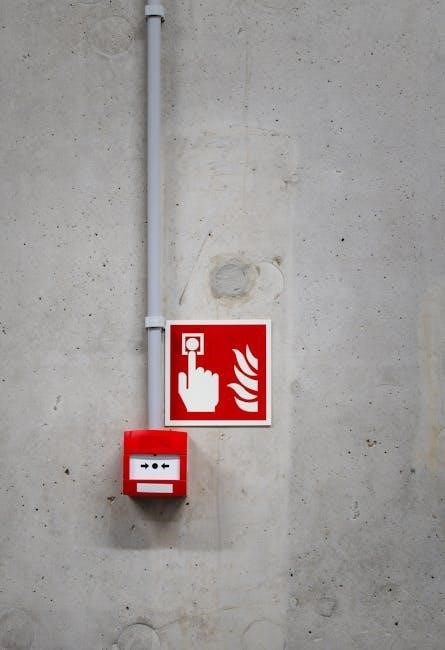A manual pull station is a critical component of fire alarm systems, enabling individuals to initiate an alarm during emergencies. Its simple design ensures quick activation, playing a vital role in fire safety by providing an immediate alert system for building occupants.
1.1 Definition and Purpose
A manual pull station is a critical fire safety device that allows individuals to manually trigger a fire alarm in emergency situations. It is typically a wall-mounted unit, often red in color, designed for easy access and visibility.
The primary purpose of a manual pull station is to provide a reliable means of initiating a fire alarm when a fire or other emergency is detected. This ensures timely alerts, enabling occupants to evacuate safely and fire responders to act quickly.
1.2 Overview of Fire Alarm Systems
Fire alarm systems are designed to detect and alert individuals of potential fire hazards. These systems integrate various components, including smoke detectors, heat sensors, and manual pull stations, to ensure early warning and prompt evacuation. By combining automated detection with manual activation, fire alarm systems provide a comprehensive safety solution, enhancing response times and minimizing risks in emergency situations.

Understanding Manual Pull Stations
Manual pull stations are wall-mounted devices with a lever or button for manual activation. They are essential for initiating fire alarms in emergency situations.
2.1 Components of a Manual Pull Station
A manual pull station typically consists of a durable housing, a lever or button for activation, and internal wiring connected to the fire alarm system. The housing is usually made of robust materials to withstand tampering and environmental conditions. Inside, the mechanism includes a switch that triggers the alarm when activated. Some models may feature protective covers or addressable technology for advanced functionality.
2.2 How Manual Pull Stations Work
A manual pull station operates when an individual pulls the lever or presses the button, triggering the fire alarm system. This action activates the internal switch, sending an electrical signal to the fire alarm control panel. The panel then processes the signal, initiating alarms, notifications, and potentially other safety measures like sprinkler systems. The simplicity of this mechanism ensures rapid response during emergencies, enhancing overall fire safety effectiveness and reliability.
2.3 Types of Manual Pull Stations
Manual pull stations are available in two primary types: single-action and double-action. Single-action stations activate the alarm with a straightforward pull of the lever, while double-action stations require lifting a cover or performing an additional step before activation. Both designs ensure intentional activation, reducing false alarms. Some models also feature addressable technology, allowing precise location identification of the activated station, enhancing response efficiency during emergencies.
Importance of Manual Pull Stations in Fire Safety
Manual pull stations are crucial for reliable fire alarm activation, ensuring rapid response during emergencies. They serve as a failsafe, complementing automatic detection systems and enhancing overall safety.
3.1 Role in Early Fire Detection
Manual pull stations play a vital role in early fire detection by allowing individuals to trigger alarms upon spotting a fire, ensuring timely evacuation and minimizing potential damage.
3.2 Compliance with Fire Safety Regulations
Manual pull stations ensure compliance with fire safety regulations by providing a reliable means of alarm activation. They must meet standards like NFPA 72, ensuring proper placement, visibility, and functionality. Regular inspections and testing are required to maintain compliance, ensuring the devices function correctly during emergencies. Adherence to these regulations helps buildings pass safety inspections and ensures occupant safety, aligning with legal and industry standards for fire protection systems.

Installation and Placement of Manual Pull Stations
Manual pull stations are typically wall-mounted near exits, ensuring easy access. They must be installed between 42-48 inches from the floor for accessibility and visibility.
4.1 Requirements for Placement
Manual pull stations must be installed in accessible locations, such as near exits, stairways, and corridors. They should be placed between 42 and 48 inches above the floor to ensure accessibility for all individuals. The NFPA 72 standard mandates that pull stations must be visible, unobstructed, and within 5 feet of exit doors. Proper placement ensures quick activation during emergencies, aiding in timely evacuations and fire response.
4.2 Installation Best Practices
Manual pull stations should be installed by certified professionals, ensuring compliance with NFPA 72 standards. Post-installation testing is crucial to verify functionality. Stations must be securely mounted to walls to prevent tampering and ensure durability. Protective covers, when permitted, can prevent accidental activation. Clear labeling and visibility are essential for quick identification during emergencies. Proper installation ensures reliable performance and adherence to fire safety regulations, guaranteeing effective emergency response capabilities.

Codes and Standards Governing Manual Pull Stations
Manual pull stations must comply with NFPA 72 and local fire codes, ensuring proper installation, functionality, and safety. These standards dictate design, placement, and testing requirements.
5.1 NFPA 72 Requirements
NFPA 72 mandates specific requirements for manual pull stations, including placement, accessibility, and tamper resistance. These stations must be clearly visible and reachable, typically between 42 and 48 inches above the floor. NFPA 72 also outlines testing and inspection frequencies to ensure reliability. Compliance with these standards is crucial for maintaining fire safety and meeting legal obligations in commercial and public buildings.
5.2 Local Fire Codes and Regulations
Local fire codes and regulations often complement NFPA standards, adding specific requirements for manual pull stations based on regional risks and building types. These codes may dictate placement, visibility, and accessibility, ensuring stations are strategically located for emergencies. Fire officials may permit additional features, such as protective covers, to prevent tampering. Compliance with local regulations is essential to meet legal and safety standards, ensuring effective fire response capabilities tailored to specific environments and communities.
Maintenance and Testing of Manual Pull Stations
Regular maintenance and testing of manual pull stations ensure reliability and compliance with fire safety standards. Inspections and functional tests verify proper operation and address potential issues promptly.
6.1 Regular Inspection Requirements
Regular inspections of manual pull stations are essential to ensure proper functionality. NFPA 72 mandates monthly visual inspections to check for damage, tampering, or obstructions. Annual testing involves activating the station to verify alarm operation. Technicians should also inspect the reset mechanism and ensure proper labeling. Any issues must be documented and addressed promptly to maintain compliance and reliability of the fire safety system.
6.2 Testing Procedures
Testing manual pull stations ensures their reliability in emergencies. Activate the station, verify the alarm triggers, and check the control panel for signal receipt. Ensure the system resets properly after testing. Perform tests annually or as per NFPA 72 guidelines. Document all test results and address any issues promptly. Only authorized personnel should conduct these tests to prevent false alarms and maintain system integrity.
Advanced Features of Modern Manual Pull Stations
Modern manual pull stations offer advanced features like addressable and wireless options, enabling precise location identification and seamless integration with fire safety systems, enhancing emergency response efficiency.
7.1 Addressable Pull Stations
Addressable pull stations provide enhanced functionality by pinpointing the exact location of activation within a building. This feature is crucial for large facilities, as it allows security personnel to quickly identify the source of the alarm, ensuring a swift and targeted response. These stations integrate seamlessly with modern fire alarm systems, offering precise communication and improving emergency management efficiency significantly.
7.2 Wireless Manual Pull Stations
Wireless manual pull stations offer a flexible and reliable solution for fire alarm systems, eliminating the need for complex wiring. These stations use wireless communication to send signals to the control panel, ensuring rapid activation during emergencies. Their ease of installation and maintenance makes them ideal for retrofitting older buildings or temporary structures, while maintaining the highest standards of fire safety and reliability.

Integration with Other Fire Safety Systems
Manual pull stations seamlessly integrate with smoke detectors, alarms, and building management systems, enhancing overall fire safety by ensuring rapid response and comprehensive emergency alerts.
8.1 Integration with Smoke Detectors and Alarms
Manual pull stations work alongside smoke detectors and alarms to create a robust fire safety network. When a pull station is activated, it triggers the alarm system, ensuring immediate notification. Smoke detectors provide early detection, while pull stations offer a manual backup, enhancing reliability. This integration ensures comprehensive coverage, addressing both automatic and manual activation needs for a swift emergency response.
8.2 Compatibility with Building Management Systems
Manual pull stations can seamlessly integrate with building management systems (BMS), enhancing overall fire safety management. This integration allows for centralized monitoring and control, ensuring alarms are quickly identified and addressed. Advanced systems, like NOTIFIER, enable detailed event logging and real-time status updates. Compatibility with BMS ensures efficient coordination between fire safety and other building systems, improving emergency response times and system reliability.
Troubleshooting Common Issues
Identifying and resolving issues like faulty activation, wiring problems, or mechanical failures ensures reliable operation. Regular checks help prevent false alarms and system downtime effectively.
9.1 Common Malfunctions
Manual pull stations may experience issues like mechanical failures, wiring faults, or environmental damage. Corrosion, tamper switch problems, and cover interference can also occur. Addressing these promptly ensures reliability.
9.2 Resetting and Repairing Manual Pull Stations
Resetting a manual pull station involves ensuring the alarm system is cleared and the device is returned to its ready state. Repairs often require replacing damaged components like levers or contacts. Qualified personnel should perform these tasks to maintain system integrity. Advanced models, such as addressable pull stations, may offer diagnostic features to simplify troubleshooting and ensure proper functionality after repairs. Regular testing post-repair is essential to confirm reliability.
Manual pull stations are a critical component of fire safety, ensuring rapid response and compliance with safety codes. Their simple yet effective design makes them indispensable in emergencies, providing a reliable means to alert others. Proper installation, maintenance, and integration with other systems enhance their functionality. As technology evolves, manual pull stations continue to play a vital role in saving lives and protecting property, remaining a cornerstone of fire safety strategies worldwide.
